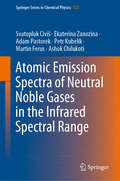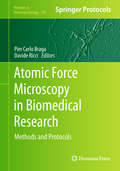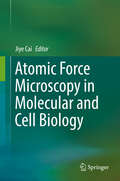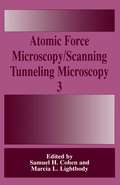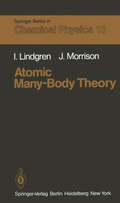- Table View
- List View
Atomic Emission Spectra of Neutral Noble Gases in the Infrared Spectral Range (Springer Series in Chemical Physics #122)
by Svatopluk Civiš Ekaterina Zanozina Adam Pastorek Petr Kubelík Martin Ferus Ashok ChilukotiThis book is an invaluable guide to calibrating any infrared spectrum using noble gases as a reference. Featuring a detailed graphical and tabular overview of highly excited (Rydberg) states of neutral noble gases in the infrared range of 700–7000 cm-1, it helps researchers by providing high-precision experimental data that can be used in almost every infrared spectroscopic laboratory.
Atomic Evidence: Seeing the Molecular Basis of Life
by David S. GoodsellThis book will take an evidence-based approach to current knowledge about biomolecules and their place in our lives, inviting readers to explore how we know what we know, and how current gaps in knowledge may influence the way we approach the information. Biomolecular science is increasingly important in our everyday life, influencing the choices we make about our diet, our health, and our wellness. Often, however, information about biomolecular science is presented as a list of immutable facts, discouraging critical thought. The book will introduce the basic tools of structural biology, supply real-life examples, and encourage critical thought about aspects of biology that are still not fully understood.
Atomic Force Microscopy: Understanding Basic Modes and Advanced Applications
by Greg HaugstadThis book enlightens readers on the basic surface properties and distance-dependent intersurface forces one must understand to obtain even simple data from an atomic force microscope (AFM). The material becomes progressively more complex throughout the book, explaining details of calibration, physical origin of artifacts, and signal/noise limitations. Coverage spans imaging, materials property characterization, in-liquid interfacial analysis, tribology, and electromagnetic interactions. “Supplementary material for this book can be found by entering ISBN 9780470638828 on booksupport.wiley.com”
Atomic Force Microscopy: Understanding Basic Modes and Advanced Applications
by Greg HaugstadThis book enlightens readers on the basic surface properties and distance-dependent intersurface forces one must understand to obtain even simple data from an atomic force microscope (AFM). The material becomes progressively more complex throughout the book, explaining details of calibration, physical origin of artifacts, and signal/noise limitations. Coverage spans imaging, materials property characterization, in-liquid interfacial analysis, tribology, and electromagnetic interactions. “Supplementary material for this book can be found by entering ISBN 9780470638828 on booksupport.wiley.com”
Atomic Force Microscopy: Biomedical Methods and Applications (Methods in Molecular Biology #242)
by Pier Carlo Braga and Davide RicciThe natural, biological, medical, and related sciences would not be what they are today without the microscope. After the introduction of the optical microscope, a second breakthrough in morphostructural surface analysis occurred in the 1940s with the development of the scanning electron microscope (SEM), which, instead of light (i. e. , photons) and glass lenses, uses electrons and electromagnetic lenses (magnetic coils). Optical and scanning (or transmission) electron microscopes are called “far-field microscopes” because of the long distance between the sample and the point at which the image is obtained in comparison with the wavelengths of the photons or electrons involved. In this case, the image is a diffraction pattern and its resolution is wavelength limited. In 1986, a completely new type of microscopy was proposed, which, without the use of lenses, photons, or electrons, directly explores the sample surface by means of mechanical scanning, thus opening up unexpected possibilities for the morphostructural and mechanical analysis of biological specimens. These new scanning probe microscopes are based on the concept of near-field microscopy, which overcomes the problem of the limited diffraction-related resolution inherent in conventional microscopes. Located in the immediate vicinity of the sample itself (usually within a few nanometers), the probe records the intensity, rather than the interference signal, thus significantly improving resolution. Since the most we- known microscopes of this type operate using atomic forces, they are frequently referred to as atomic force microscopes (AFMs).
Atomic Force Microscopy: Methods and Protocols (Methods in Molecular Biology #1886)
by Nuno C. Santos Filomena A. CarvalhoThis book aims to provide examples of applications of atomic force microscopy (AFM) using biological samples, showing different methods for AFM sample preparation, data acquisition and processing, and avoiding technical problems. Divided into two sections, chapters guide readers through image artifacts, process and quantitatively analyze AFM images, lipid bilayers, image DNA-protein complexes, AFM cell topography, single-molecule force spectroscopy, single-molecule dynamic force spectroscopy, fluorescence methodologies, molecular recognition force spectroscopy, biomechanical characterization, AFM-based biosensor setup, and detail how to implement such an in vitro system, which can monitor cardiac electrophysiology, intracellular calcium dynamics, and single cell mechanics. Written in the highly successful Methods in Molecular Biology series format, chapters include introductions to their respective topics, lists of the necessary materials and reagents, step-by-step, readily reproducible laboratory protocols, and tips on troubleshooting and avoiding known pitfalls.Authoritative and cutting-edge, Atomic Force Microscopy: Methods and Protocols is useful for researchers at different stages, from newcomers to experienced users, interested in new AFM applications.
Atomic Force Microscopy: A New Look at Microbes (Synthesis Lectures on Materials and Optics)
by Ahmed TouhamiOver the last two decades, Atomic Force Microscopy (AFM) has undoubtedly had a considerable impact in unraveling the structures and dynamics of microbial surfaces with nanometer resolution, and under physiological conditions. Moreover, the continuous innovations in AFM-based modalities as well as the combination of AFM with modern optical techniques, such as confocal fluorescence microscopy or Raman spectroscopy, increased the diversity and volume of data that can be acquired in an experiment. It is evident that these combinations provide new ways to investigate a broad spectrum of microbiological processes at the level of single cells. In this book, I have endeavored to highlight the wealth of AFM-based modalities that have been implemented over the recent years leading to the multiparametric and multifunctional characterization of, specifically, bacterial surfaces. Examples include the real-time imaging of the nanoscale organization of cell walls, the quantification of subcellular chemical heterogeneities, the mapping and functional analysis of individual cell wall constituents, and the probing of the nanomechanical properties of living bacteria. It is expected that in the near future more AFM-based modalities and complementary techniques will be combined into single experiments to address pertinent problems and challenges in microbial research. Such improvements may make it possible to address the dynamic nature of many more microbial cell surfaces and their constituents, including the restructuring of cellular membranes, pores and transporters, signaling of cell membrane receptors, and formation of cell-adhesion complexes. Ultimately, manifold discoveries and engineering possibilities will materialize as multiparametric tools allow systems of increasing complexity to be probed and manipulated.
Atomic Force Microscopy (NanoScience and Technology)
by Bert VoigtländerThis book explains the operating principles of atomic force microscopy with the aim of enabling the reader to operate a scanning probe microscope successfully and understand the data obtained with the microscope. This enhanced second edition to "Scanning Probe Microscopy" (Springer, 2015) represents a substantial extension and revision to the part on atomic force microscopy of the previous book. Covering both fundamental and important technical aspects of atomic force microscopy, this book concentrates on the principles the methods using a didactic approach in an easily digestible manner. While primarily aimed at graduate students in physics, materials science, chemistry, nanoscience and engineering, this book is also useful for professionals and newcomers in the field, and is an ideal reference book in any atomic force microscopy lab.
Atomic Force Microscopy for Energy Research (Emerging Materials and Technologies)
by Cai ShenAtomic force microscopy (AFM) can be used to analyze and measure the physical properties of all kinds of materials at nanoscale in the atmosphere, liquid phase, and ultra-high vacuum environment. It has become an important tool for nanoscience research. In this book, the basic principles of functional AFM techniques and their applications in energy materials—such as lithium-ion batteries, solar cells, and other energy-related materials—are addressed. FEATURES First book to focus on application of AFM for energy research Details the use of advanced AFM and addresses many types of functional AFM tools Enables readers to operate an AFM instrument successfully and to understand the data obtained Covers new achievements in AFM instruments, including electrochemical strain microscopy, and how AFM is being combined with other new methods such as infrared (IR) spectroscopy With its substantial content and logical structure, Atomic Force Microscopy for Energy Research is a valuable reference for researchers in materials science, chemistry, and physics who are working with AFM or planning to use it in their own fields of research, especially energy research.
Atomic Force Microscopy for Energy Research (Emerging Materials and Technologies)
by Cai ShenAtomic force microscopy (AFM) can be used to analyze and measure the physical properties of all kinds of materials at nanoscale in the atmosphere, liquid phase, and ultra-high vacuum environment. It has become an important tool for nanoscience research. In this book, the basic principles of functional AFM techniques and their applications in energy materials—such as lithium-ion batteries, solar cells, and other energy-related materials—are addressed. FEATURES First book to focus on application of AFM for energy research Details the use of advanced AFM and addresses many types of functional AFM tools Enables readers to operate an AFM instrument successfully and to understand the data obtained Covers new achievements in AFM instruments, including electrochemical strain microscopy, and how AFM is being combined with other new methods such as infrared (IR) spectroscopy With its substantial content and logical structure, Atomic Force Microscopy for Energy Research is a valuable reference for researchers in materials science, chemistry, and physics who are working with AFM or planning to use it in their own fields of research, especially energy research.
Atomic Force Microscopy in Biomedical Research: Methods and Protocols (Methods in Molecular Biology #736)
by Pier Carlo Braga and Davide RicciWith its ability to explore the surface of the sample by means of a local scanning probe and its use of dedicated software allows to be visualize results, atomic force microscopy (AFM) has revolutionized the study of the smallest aspects of life. Atomic Force Microscopy in Biomedical Research: Methods and Protocols proves that this technology is no longer simply just another form of microscopy but has given rise to a completely new way of using microscopy that fulfils the dreams of all microscopists: being able to touch, move, and interact with the sample while it is being examined, thus making it possible to discover not only morphological but also chemical and physical structural information. Covering such topics as molecule imaging, nanoscale surface analysis and cellular imaging, force-spectroscopy, investigating drug action, and AFM as a nanotool, this volume features the most up-to-date techniques currently in use. Written in the Methods in Molecular Biology™ series format, chapters include introductions to their respective topics, lists of the necessary materials, step-by-step, readily reproducible protocols, and expert tips on troubleshooting and avoiding known pitfalls. Comprehensive and cutting-edge, Atomic Force Microscopy in Biomedical Research: Methods and Protocols brings together different types of applications in order to provide examples from diverse fields in the hope of inspiring researchers to apply their ingenuity in their own specialization and add significant originality to their varying studies.
Atomic Force Microscopy in Liquid: Biological Applications
by Arturo M. Baró Ronald G. ReifenbergerAbout 40 % of current atomic force microscopy (AFM) research is performed in liquids, making liquid-based AFM a rapidly growing and important tool for the study of biological materials. This book focuses on the underlying principles and experimental aspects of AFM under liquid, with an easy-to-follow organization intended for new AFM scientists. The book also serves as an up-to-date review of new AFM techniques developed especially for biological samples. Aimed at physicists, materials scientists, biologists, analytical chemists, and medicinal chemists. An ideal reference book for libraries. From the contents: Part I: General Atomic Force Microscopy * AFM: Basic Concepts * Carbon Nanotube Tips in Atomic Force Microscopy with * Applications to Imaging in Liquid * Force Spectroscopy * Atomic Force Microscopy in Liquid * Fundamentals of AFM Cantilever Dynamics in Liquid * Environments * Single-Molecule Force Spectroscopy * High-Speed AFM for Observing Dynamic Processes in Liquid * Integration of AFM with Optical Microscopy Techniques Part II: Biological Applications * DNA and Protein-DNA Complexes * Single-Molecule Force Microscopy of Cellular Sensors * AFM-Based Single-Cell Force Spectroscopy * Nano-Surgical Manipulation of Living Cells with the AFM
Atomic Force Microscopy in Liquid: Biological Applications
by rer.nat. Georg J. Schmitz Ulrich PrahlAbout 40 % of current atomic force microscopy (AFM) research is performed in liquids, making liquid-based AFM a rapidly growing and important tool for the study of biological materials. This book focuses on the underlying principles and experimental aspects of AFM under liquid, with an easy-to-follow organization intended for new AFM scientists. The book also serves as an up-to-date review of new AFM techniques developed especially for biological samples. Aimed at physicists, materials scientists, biologists, analytical chemists, and medicinal chemists. An ideal reference book for libraries. From the contents: Part I: General Atomic Force Microscopy * AFM: Basic Concepts * Carbon Nanotube Tips in Atomic Force Microscopy with * Applications to Imaging in Liquid * Force Spectroscopy * Atomic Force Microscopy in Liquid * Fundamentals of AFM Cantilever Dynamics in Liquid * Environments * Single-Molecule Force Spectroscopy * High-Speed AFM for Observing Dynamic Processes in Liquid * Integration of AFM with Optical Microscopy Techniques Part II: Biological Applications * DNA and Protein-DNA Complexes * Single-Molecule Force Microscopy of Cellular Sensors * AFM-Based Single-Cell Force Spectroscopy * Nano-Surgical Manipulation of Living Cells with the AFM
Atomic Force Microscopy in Molecular and Cell Biology
by Jiye CaiThe book addresses new achievements in AFM instruments – e.g. higher speed and higher resolution – and how AFM is being combined with other new methods like NSOM, STED, STORM, PALM, and Raman. This book explores the latest advances in atomic force microscopy and related techniques in molecular and cell biology. Atomic force microscopy (AFM) can be used to detect the superstructures of the cell membrane, cell morphology, cell skeletons and their mechanical properties. Opening up new fields of in-situ dynamic study for living cells, enzymatic reactions, fibril growth and biomedical research, these combined techniques will yield valuable new insights into molecule and cell biology. This book offers a valuable resource for students and researchers in the fields of biochemistry, cell research and chemistry etc.
Atomic Force Microscopy in Nanobiology
by Kunio TakeyasuRecent developments in atomic force microscopy (AFM) have been accomplished through various technical and instrumental innovations, including high-resolution and recognition imaging technology under physiological conditions, fast-scanning AFM, and general methods for cantilever modification and force measurement. All these techniques are now highly
Atomic Force Microscopy, Scanning Nearfield Optical Microscopy and Nanoscratching: Application to Rough and Natural Surfaces (NanoScience and Technology)
by Gerd KauppMaking a clear distinction is made between nano- and micro-mechanical testing for physical reasons, this monograph describes the basics and applications of the supermicroscopies AFM and SNOM, and of the nanomechanical testing on rough and technical natural surfaces in the submicron range down to a lateral resolution of a few nm. New or improved instrumentation, new physical laws and unforeseen new applications in all branches of natural sciences (around physics, chemistry, mineralogy, materials science, biology and medicine) and nanotechnology are covered as well as the sources for pitfalls and errors. It outlines the handling of natural and technical samples in relation to those of flat standard samples and emphasizes new special features. Pitfalls and sources of errors are clearly demonstrated as well as their efficient remedy when going from molecularly flat to rough surfaces. The academic or industrial scientist learns how to apply the principles for tackling their scientific or manufacturing tasks that include roughness far away from standard samples.
Atomic Force Microscopy/Scanning Tunneling Microscopy
by M. T. Bray Samuel H. Cohen Marcia L. LightbodyThe first U. S. Army Natick Research, Development and Engineering Center Atomic Force/Scanning Tunneling Microscopy (AFM/STM) Symposium was held on lune 8-10, 1993 in Natick, Massachusetts. This book represents the compilation of the papers presented at the meeting. The purpose ofthis symposium was to provide a forum where scientists from a number of diverse fields could interact with one another and exchange ideas. The various topics inc1uded application of AFM/STM in material sciences, polymers, physics, biology and biotechnology, along with recent developments inc1uding new probe microscopies and frontiers in this exciting area. The meeting's format was designed to encourage communication between members of the general scientific community and those individuals who are at the cutting edge of AFM, STM and other probe microscopies. It immediately became clear that this conference enabled interdisciplinary interactions among researchers from academia, industry and government, and set the tone for future collaborations. Expert scientists from diverse scientific areas including physics, chemistry, biology, materials science and electronics were invited to participate in the symposium. The agenda of the meeting was divided into three major sessions. In the first session, Biological Nanostructure, topics ranged from AFM ofDNA to STM imagmg ofthe biomoleeule tubulin and bacterialluciferase to the AFM of starch polymer double helices to AFM imaging of food surfaces.
Atomic Force Microscopy/Scanning Tunneling Microscopy 2
by Samuel H. Cohen Marcia L. LightbodyThis book represents the compilation of papers presented at the second Atomic Force Microscopy/Scanning Tunneling Microscopy (AFM/STM) Symposium, held June 7 to 9, 1994, in Natick, Massachusetts, at Natick Research, Development and Engineering Center, now part ofU.S. Army Soldier Systems Command. As with the 1993 symposium, the 1994 symposium provided a forum where scientists with a common interest in AFM, STM, and other probe microscopies could interact with one another, exchange ideas and explore the possibilities for future collaborations and working relationships. In addition to the scheduled talks and poster sessions, there was an equipment exhibit featuring the newest state-of-the-art AFM/STM microscopes, other probe microscopes, imaging hardware and software, as well as the latest microscope-related and sample preparation accessories. These were all very favorably received by the meeting's attendees. Following opening remarks by Natick's Commander, Colonel Morris E. Price, Jr., and the Technical Director, Dr. Robert W. Lewis, the symposium began with the Keynote Address given by Dr. Michael F. Crommie from Boston University. The agenda was divided into four major sessions. The papers (and posters) presented at the symposium represented a broad spectrum of topics in atomic force microscopy, scanning tunneling microscopy, and other probe microscopies.
Atomic Force Microscopy/Scanning Tunneling Microscopy 3
by Samuel H. Cohen Marcia L. LightbodyThe Foundation for Advances in Medicine and Science (FAMS), the organizers of SCANNING 98, sponsored its third annual Atomic Force Microscopy/Scanning Tunneling Microscopy Symposium at the Omni Inner Harbor Hotelin Baltimore, Maryland, from May 9 to 12, 1998. This book represents the compilation of papers that were presented at the AFM/STM Symposium as well as a few that were presented at SCANNING 96 and SCANNING 97 meetings that took place in Monterey, California. The purpose of the symposium was to provide an interface between scientists and engineers, representatives of industry, government and academia, all of whom have a common interest in probe microscopies. The meetings offered an ideal forum where ideas could easily be exchanged and where individuals from diverse fields who are on the cutting edge ofprobe microscopy research could communicate with one another. Experts in probe microscopy from around the world representing a wide range of disciplines including physics, biotechnology, nanotechnology, chemistry, material science, etc., were invited to participate. The format of the meeting was structured so as to encourage communication among these individuals. During the first day’s sessions papers were presented on general topics such as application of scanning probe microscopy in materials science; STM and scanning tunneling spectroscopy of organic materials; fractal analysis in AFM; and nanomanipulation. Other papers presented included unexpected ordering of a molecule; synthesis ofpeptides and oligonucleotides; and analysis oflunar soils from Apollo 11.
The Atomic Human: Understanding Ourselves in the Age of AI
by Neil D. Lawrence‘The clarity, authority, wit and insight Lawrence brings to bear are like torches shining into the turbulent darkness of a subject we all wonder at, but which we mostly feel unable to even to think or talk about with any confidence. Hugely recommended’ Stephen FryWhat does Artificial Intelligence mean for our identity? Our fascination with AI stems from the perceived uniqueness of human intelligence. We believe it's what differentiates us. Fears of AI not only concern how it invades our digital lives, but also the implied threat of an intelligence that displaces us from our position at the centre of the world.Neil D. Lawrence's visionary book shows why these fears may be misplaced. Atomism, proposed by Democritus, suggested it was impossible to continue dividing matter down into ever smaller components: eventually we reach a point where a cut cannot be made (the Greek for uncuttable is 'atom'). In the same way, by slicing away at the facets of human intelligence that can be replaced by machines, AI uncovers what is left: an indivisible core that is the essence of humanity.Human intelligence has evolved across hundreds of thousands of years. Due to our physical and cognitive constraints over that time, it is social and highly embodied. By contrasting our capabilities with machine intelligence, The Atomic Human reveals the technical origins, capabilities and limitations of AI systems, and how they should be wielded. Not just by the experts, but ordinary people. Understanding this will enable readers to choose the future we want – either one where AI is a tool for us, or where we become a tool of AI – and how to counteract the digital oligarchy to maintain the fabric of an open, fair and democratic society.
Atomic Hypothesis and the Concept of Molecular Structure (Tertiary Level Biology)
by L. D. Barron J. E. Boggs Jens Peder Dahl Z. B. Maksic A. Y. Meyer O. E. Polansky B. T. Sutcliffe K. B. Wiberg"Imagination and shrewd guesswork are powerful instruments for acquiring scientific knowledge . . . " 1. H. van't Hoff The last decades have witnessed a rapid growth of quantum chemistry and a tremendous increase in the number of very accurate ab initio calculations of the electronic structure of molecules yielding results of admirable accuracy. This dramatic progress has opened a new stage in the quantum mechanical description of matter at the molecular level. In the first place, highly accurate results provide severe tests of the quantum mecha nics. Secondly, modern quantitative computational ab initio methods can be synergetically combined with various experimen tal techniques thus enabling precise numerical characterization of molecular properties better than ever anticipated earlier. However, the role of theory is not exhausted in disclosing the fundamental laws of Nature and production of ever increasing sets of data of high accuracy. It has to provide additionally a means of systematization, recognition of regularities, and ratio nalization of the myriads of established facts avoiding in this way complete chaos. Additional problems are represented by molecular wavefunctions provided by the modern high-level computational quantum chemistry methods. They involve, in principle, all the information on molecular system, but they are so immensely complex that can not be immediately understood in simple and physically meaningful terms. Both of these aspects, categorization and interpretation, call for conceptual models which should be preferably pictorial, transparent, intuitively appealing and well-founded, being sometimes useful for semi quantitative purposes.
Atomic Inner-Shell Physics (Physics of Atoms and Molecules)
by Bernd CrasemannThe physics of atomic inner shells has undergone significant advances in recent years. Fast computers and new experimental tools, notably syn chrotron-radiation sources and heavy-ion accelerators, have greatly enhan ced the scope of problems that are accessible. The level of research activity is growing substantially; added incentives are provided by the importance of inner-shell processes in such diverse areas as plasma studies, astrophysics, laser technology, biology, medicine, and materials science. The main reason for all this exciting activity in atomic inner-shell physics, to be sure, lies in the significance of the fundamental problems that are coming within grasp. The large energies of many inner-shell processes cause relativistic and quantum-electrodynamic effects to become strong. Unique opportunities exist for delicate tests of such phenomena as the screening of the electron self-energy and the limits of validity of the present form of the frequency-dependent Breit interaction, to name but two. The many-body problem, which pervades virtually all of physics, presents somewhat less intractable aspects in the atomic inner-shell regime: correlations are relatively weak so that they can be treated perturbatively, and the basic potential is simple and known! The dynamics of inner-shell processes are characterized by exceedingly short lifetimes and high transition rates that strain perturbation theory to its limits and obliterate the traditional separation of excitation and deexcitation. These factors are only now being explored, as are interference phenomena between the various channels.
Atomic Layer Deposition for Semiconductors
by Cheol Seong HwangOffering thorough coverage of atomic layer deposition (ALD), this book moves from basic chemistry of ALD and modeling of processes to examine ALD in memory, logic devices and machines. Reviews history, operating principles and ALD processes for each device.
Atomic Love
by Jennie FieldsThe stunning novel about our fiercest loyalties, deepest desires and the power of forgiveness 'Science, love, espionage, and a heroine who carves a strong path in the world of men. There is nothing left to want' Ann Patchett'A highly-charged love story' Delia Owens, bestselling author of Where the Crawdads SingChicago, 1950.Rosalind Porter has always defied expectations - in her work as a physicist on the Manhattan Project to design the atomic bomb, and in her passionate love affair with coworker Thomas Weaver.Five years after the end of both, her guilt over the results of her work and her heartbreak over Weaver are intertwined. She has almost succeeded in resigning herself to a more conventional life . . .Then Weaver gets back in touch. But so does the FBI.Agent Charlie Szydlo wants Rosalind to spy on Weaver, whom the FBI suspects of selling nuclear secrets to Russia.As Rosalind's final assignment launches her on a dangerous mission to find the truth, she faces a heartbreaking choice . . .Believe the man who taught her how to love?Or trust the man who her love might save?READERS ARE ENTRANCED BY ATOMIC LOVE:'A complex literary thriller with a beating heart that finds new ways of asking old questions about love and desire' 5***** Reader Review'A phenomenal read - fundamentally a love story but so much more as well' 5***** Reader Review'Pure pleasure all the way, managing to be both page-turning while pulling you in deep' 5***** Reader Review
Atomic Many-Body Theory (Springer Series in Chemical Physics #13)
by I. Lindgren J. MorrisonThis book has developed through a series of lectures on atomic theory given these last eight years at Chalmers University of Technology and several oth er research centers. These courses were intended to make the basic elements of atomic theory available to experimentalists working with the hyperfine structure and the optical properties of atoms and to provide some insight into recent developments in the theory. The original intention of this book has gradually extended to include a wide range of topics. We have tried to provide a complete description of atomic theory, bridging the gap between introductory books on quantum mechanics - such as the book by Merzbacher, for instance - and present day research in the field. Our presentation is limited to static atomic prop erties, such as the effective electron-electron interaction, but the formalism can be extended without major difficulties to include dynamic properties, such as transition probabilities and dynamic polarizabilities.
